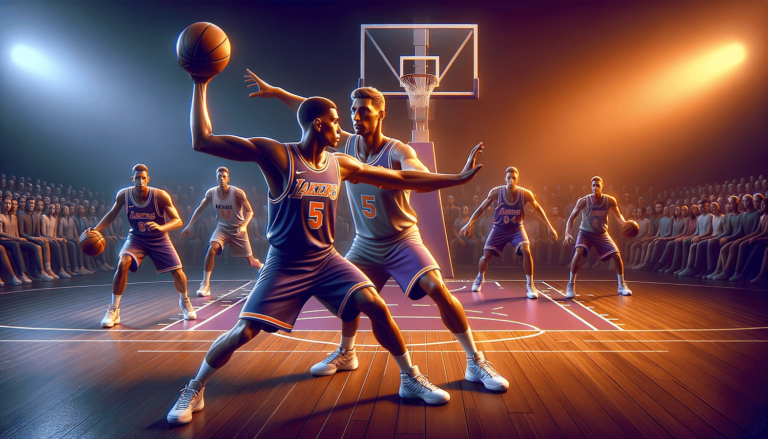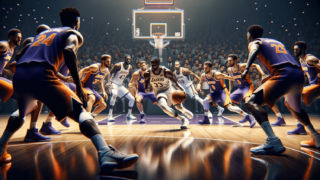
As a basketball enthusiast or passionate player, you’ve probably encountered countless techniques and strategies designed to improve your game. One such strategy that you may have heard or seen on the court is the infamous “Give and Go” cut. This clever offensive maneuver can leave opponents baffled and give your team the upper hand, all while showcasing your crisp passing and agility. In today’s blog post, we’ll delve into the world of the Give and Go cut, dissecting the concept, executing the perfect move, and providing insights that will take your understanding of this basketball staple to the next level. So, lace up those sneakers and get ready to learn everything there is about the fast-paced, dynamic Give and Go cut!
What’s a Give and Go Cut in Basketball?
A Give and Go cut is a fundamental basketball offensive move where a player passes the ball to a teammate, immediately moves towards the basket, and positions themselves to receive the ball back for an easy scoring opportunity. This particular move leverages quick ball movement and player agility to create space for an open layup, jump shot, or drive to the basket. The key to a successful Give and Go cut is precise timing, effective communication between teammates, and exploiting the defenders’ momentary lapse in focus.
Breaking Down the Give and Go Cut
Before we jump into the nitty-gritty of the Give and Go cut, let’s first break down the mechanics of this basketball move. There are three essential components to a Give and Go cut: the initial pass, the cut, and the return pass. Each phase plays a crucial role in the success of the move, and mastering each component will help you become a more effective player on the court.
Phase 1: The Initial Pass
The Give and Go cut begins with an offensive player holding the ball, surveying the court for an opportunity to create an advantage. The player then passes the ball to a teammate, ideally someone positioned at the wing or the top of the key. It is vital that this pass is quick and accurate to set up the subsequent move.
Phase 2: The Cut
As soon as the initial pass is made, the player who has just passed the ball aggressively cuts towards the basket. This cut, which is the namesake of the move, should be swift, decisive, and have a clear purpose. It’s essential to take advantage of the defenders’ momentary focus on the receiver of the initial pass or any existing defensive miscommunication.
Phase 3: The Return Pass
The success of the Give and Go cut lies in the return pass. The player who received the initial pass must quickly recognize their teammate’s cutting movement and make a timely, accurate pass back to the cutter. This return pass should ideally find the cutter in stride, leading to an open layup, jump shot, or drive to the basket.
Moving Parts of a Successful Give and Go Cut
Now that we have dissected the individual components of the Give and Go cut, let’s focus on the interconnected elements that make this basketball move successful. It all comes down to effective communication, precise timing, and exploiting the opponent’s defensive strategy.
Effective Communication
Although the Give and Go cut primarily relies on non-verbal cues for coordination, communication remains a critical aspect of the move. Players must recognize the opportunity to execute the cut and be on the same page with their passing and movement. This communication can come in the form of eye contact or predetermined signals; however, it should remain subtle to avoid alerting the defense.
Precise Timing
Perfect timing is paramount in making the Give and Go cut work. It begins with the instant recognition of an advantage and continues through the seamless execution of the pass, cut, and return pass. Improper timing of any phase can break down the move, resulting in turnovers or missed scoring opportunities.
Exploiting the Defense
The key to a successful Give and Go cut is understanding how to exploit the opponent’s defensive strategies. As players grow proficient in performing the move, they can adapt and make the most of each situation presented on the court. Awareness of defensive switches or communication breakdowns will give the cutter a greater opportunity to execute the play.
The Art of the Cut
Mastering the cutting portion of the Give and Go will increase the move’s success rate significantly. Several aspects contribute to a well-executed cut: aggressiveness, reading the defender, and maintaining proper spacing.
Aggressiveness
To perform a successful cut in a Give and Go play, the cutter must be fast and decisive. An aggressive cut will force defenders to react quickly, providing more significant scoring opportunities by exploiting their hesitation.
Reading the Defender
A critical aspect of the cutting phase is reading the defender’s positioning and reacting accordingly. Understanding where the defender is in relation to the cutter and the basket will help determine the best path for the cut. It’s essential to avoid letting the defender beat you to the spot and denying the return pass.
Proper Spacing
Spacing is a key component of any successful basketball play, and the Give and Go cut is no exception. Proper spacing allows the cutter to make a decisive move without interference from other teammates or defenders. Moreover, it helps the basketball move flow smoothly and increases the likelihood of creating a successful basket opportunity.
Benefits of the Give and Go Cut
While the Give and Go cut is just one of many offensive weapons available to basketball players, it provides several unique advantages that make it worth incorporating into your game.
Simplicity
One of the most significant benefits of the Give and Go cut is its simplicity. This fundamental move can be taught to players of all ages and skill levels, acting as a building block for more complicated plays down the line.
Quick Ball Movement
The nature of the Give and Go cut encourages quick ball movement and discourages the tendency to over-dribble. By moving the ball quickly, players create an extensive array of scoring opportunities and keep the defense off-balance.
Teamwork and Unselfishness
Executing a Give and Go cut successfully requires a high level of trust and unselfishness from both the passer and the cutter. By incorporating the Give and Go in your game or team strategy, you promote effective teamwork and build a sense of camaraderie on the court.
Incorporating the Give and Go Cut into Your Game
Now that you’re well-versed in the mechanics, timing, and advantages of the Give and Go cut, it’s time to incorporate this basketball move into your game. The following tips and practice drills will help you know when and how to execute the move and become adept at recognizing opportunities on the court.
Practice Cutting Drills
Developing a strong, decisive cutting technique should be the foundation of your Give and Go prowess. Begin by practicing cutting drills, focusing on footwork, speed, and quick changes of direction. Effective cutting will force defenders to make snap decisions and create opportunities for the Give and Go action.
Reading the Defense
As you become comfortable with your cutting abilities, begin evaluating defensive positioning during games and scrimmages. Learn to identify where the defender is in relation to the ball and the basket and take advantage of any breakdowns in communication or focus. Recognizing opportunities as they arise is crucial for executing the Give and Go cut effectively.
Master the Pass and Return
Finally, hone your passing skills to be a well-rounded offensive player to complete the Give and Go cut. Practice accurate, well-timed passes and ensure you have the necessary knowledge of various pass types to remain unpredictable to the defense. Remember, the return pass is essential to the play’s effectiveness.
Examples of Give and Go Cuts in Action
Once you have a solid foundation in the mechanics, timing, and execution of the Give and Go cut, it’s helpful to view examples of the move in action. Studying game footage can provide an invaluable perspective of how the Give and Go unfolds during actual basketball games. This analysis will assist you in adapting your skills on the court and generate opportunities for successful play execution.
Classic Give and Go Cuts
An excellent starting point for examining Give and Go cuts is in historic basketball games. Legends like Larry Bird, Magic Johnson, and John Stockton were masters at executing this fundamental move. With a keen understanding of space and timing, these players created memorable plays using the Give and Go as a reliable offensive weapon.
Modern Variations
As the game of basketball has evolved, so have the ways players execute the Give and Go cut. Modern basketball players such as Stephen Curry, LeBron James, and James Harden incorporate this time-tested move into their games. By studying contemporary examples, you can learn how the Give and Go cut is adapted to keep up with the fast-paced, high-scoring nature of today’s game.
Defending Against the Give and Go Cut
As with any offensive move in basketball, a solid defense can disrupt the Give and Go cut. To round out your understanding of this fundamental move, it’s essential to know the various defensive tactics that can neutralize the Give and Go cut. Awareness of these defensive strategies will help further hone your Give and Go game, transforming it into an unstoppable force on the court.
Maintaining Ball Pressure
Defenders assigned to the player making the initial pass should maintain constant pressure on the ball-handler. By preventing a clean-passing lane or disrupting the passer’s focus, defenders create opportunities for turnovers or force players into more difficult passes.
Defensive Switching
As the cutter makes their move, defenders can switch assignments, effectively blocking the path to the basket. This quick-reacting defensive tactic can neutralize the Give and Go cut, forcing the offense to adapt or move on to another play.
Defensive Awareness and Communication
Lastly, defenders must maintain an acute awareness of everything happening on the court. Give and Go cuts can be nullified by attentive defenders who consistently communicate with their teammates about positioning, assignments, and potential threats.
With this comprehensive breakdown of the Give and Go cut in basketball and how to defend against it, you are now equipped to incorporate this classic, effective move into your game. By continuously refining your understanding of the cut, ensuring effective communication with teammates, and studying examples from the basketball greats, you’ll be well on your way to becoming an offensive force on the court.
Drills and Exercises for Perfecting the Give and Go Cut
Developing and refining your Give and Go cut skills requires more than just understanding the mechanics and strategy behind the move. It’s essential to participate in targeted drills and exercises that emulate game situations, creating muscle memory and enhancing decision-making abilities on the court. Here are some practical drills you can incorporate into your basketball training sessions to polish the execution of the Give and Go cut.
Two-Player Give and Go Drill
This simple two-player drill focuses on perfecting the Give and Go cut fundamentals, such as accurate passing, precise timing, and sharp cutting movements. Position one player at the wing and the other at the top of the key. The player with the ball initiates the give by passing to their teammate before quickly cutting towards the basket, aiming to receive a return pass for an easy layup. Rotate positions, allowing both players to practice the essential aspects of the Give and Go cut.
Three-on-Two Continuous Give and Go Drill
In this more advanced drill, two defenders are added to the mix, increasing the complexity and requiring better decision-making from the offensive players. Set up two offensive players around the perimeter and a third in one of the low-post areas, with two defenders covering the perimeter players. The offensive player with the ball passes to one of their teammates and cuts to the basket, trying to receive a return pass. The defenders work on communication and switching in response to the cutter. After the cutter receives the return pass or the defenders interrupt the play, reset the offensive players and defenders and continue for a predetermined time or number of repetitions.
Four-on-Four Give and Go Situational Drill
This full-scale four-on-four drill helps players develop a deeper understanding of how the Give and Go cut works in the context of actual basketball games. It encourages players to look for opportunities to employ the Give and Go during live play and demands a higher level of communication and adaptability. Divide the players into two teams of four and have them play a scrimmage with a predefined focus on initiating Give and Go sequences. This drill not only helps players practice the Give and Go cut, but also assists in recognizing where it’s most effective within a typical offensive set.
Give and Go Variations to Keep Defenders Guessing
Once you have acquired proficiency in the fundamental Give and Go cut, you’ll want to integrate variations of the move to keep defenders guessing and further strengthen your basketball game. The following Give and Go variants offer new ways to exploit the defense, create scoring opportunities, and improve overall court awareness.
Backdoor Give and Go
The Backdoor Give and Go is a sneaky twist on the traditional Give and Go cut. Instead of cutting towards the basketball in a straight line, the cutter moves away from their defender, making it seem as if they’re giving up on the play. Then, the cutter quickly reverses direction and cuts backdoor to the basket, often resulting in an open lane for an easy layup. This variation leverages misdirection and deception to catch defenders off-guard.
Double Give and Go
The Double Give and Go presents a more complex variation of this fundamental move. With this variant, the initial passer executes a Give and Go with a teammate and immediately repeats the maneuver with a second teammate upon receiving the return pass. This double-repetition helps create additional scoring opportunities and further disorients the defenders. The Double Give and Go requires heightened communication and teamwork, emphasizing unselfish play and adaptability.
Fake Give and Go
The Fake Give and Go is an intriguing mix of the traditional Give and Go cut and deceptive tactics. In this variation, the initial passer feints making the cut to the basket after passing the ball, only to step back or reposition after drawing the defender. The player with the ball then attempts to score or make another play from the newfound space created by the fake cut. This cunning variation can fool even the most cautious defenders, assuming the cutter has mastered the art of faking their movements convincingly.
By consistently working on your Give and Go cut fundamentals, integrating the more advanced variations, and studying the move’s various defensive counter-strategies, you will not only elevate your understanding of this time-tested basketball move but also become a versatile and formidable force on the court.
FAQ: Give and Go Cut in Basketball
The world of basketball is full of intriguing strategies and tactics, and the Give and Go cut is just one of them. To help satiate your basketball curiosity, we’ve compiled a list of frequently asked questions about the Give and Go cut, providing concise, NLP-style answers that will supplement your understanding of this fundamental basketball move.
1. Is the Give and Go cut suitable for beginner players?
Yes, the Give and Go cut is a fundamental basketball move ideal for players of all skill levels, including beginners. Its simplicity makes it a perfect building block for learning more advanced offensive concepts as players progress in their basketball journey.
2. How important is communication in executing a Give and Go cut?
Effective communication, both verbal and non-verbal, is crucial for a successful Give and Go cut. Players must be on the same page regarding their intentions and movements to ensure accurate passes, well-timed cuts, and a seamless return pass that leads to a scoring opportunity.
3. Can taller players benefit from using the Give and Go cut in their game?
Absolutely, players of all heights can benefit from incorporating the Give and Go cut into their game; it’s all about agility, timing, and communication rather than physical stature.
4. Are there any defensive strategies to counteract the Give and Go cut?
Yes, several defensive strategies can effectively neutralize the Give and Go cut, including maintaining ball pressure, switching assignments, and fostering defensive awareness and communication among teammates.
5. How can I integrate the Give and Go cut into a motion offense?
Integrating the Give and Go cut into a motion offense requires proper spacing, swift ball movement, and timely decision-making. Reading the defense and recognizing opportunities to execute a Give and Go cut will ultimately lead to its seamless incorporation within a motion offense framework.
6. Can the Give and Go cut be used in a fast break scenario?
Yes, the Give and Go cut can be used during fast breaks as long as the players involved maintain effective communication, precise timing, and proper spacing while executing the move at a fast pace.
7. What are some key points to focus on during Give and Go cut practice drills?
During Give and Go practice drills, players should focus on mastering accurate passing, quick cuts, perfect timing, and sharp decision-making, as well as learning how to read the defense and make adjustments based on the opponents’ positioning and strategies.
8. How is the Give and Go cut different from a Pick and Roll?
While both moves involve player collaboration, the key difference lies in mechanics. The Give and Go cut focuses on a swift sequence of passes and cuts to the basket, while the Pick and Roll involves a player setting a screen for their teammate before rolling towards the basket to potentially receive the ball for a scoring opportunity.
9. Is it crucial to maintain eye contact during a Give and Go cut?
Eye contact can be beneficial during a Give and Go cut by providing subtle communication cues; however, advanced players will often rely on experience and basketball intuition to recognize their teammate’s movements and intentions without maintaining constant eye contact.
10. Can the Give and Go cut work against zone defense?
The Give and Go cut can be effective against zone defenses, though it may require additional adjustments, such as attacking gaps or seams within the zone and making swift decisions based on the defenders’ shifting positions.
11. Is the Give and Go cut limited to a two-player action?
The traditional Give and Go cut involves two players, but variations exist to involve more players, such as the Double Give and Go, where the initial passer initiates consecutive Give and Go plays with two different teammates.
12. What makes a successful cut?
A successful cut involves a combination of aggressiveness, the ability to read the defender, and maintaining proper spacing on the court. These factors contribute to the cutter getting open for the return pass and possibly scoring.
13. How can I practice the Give and Go cut without a partner?
While practicing with a partner or a group is ideal, you can still work on the Give and Go cut by practicing the individual components of the move, such as cutting movements, passing against a wall or target, and decision-making and reading imaginary defensive scenarios on the court.
Featured Posts
- No pillar pages found.





